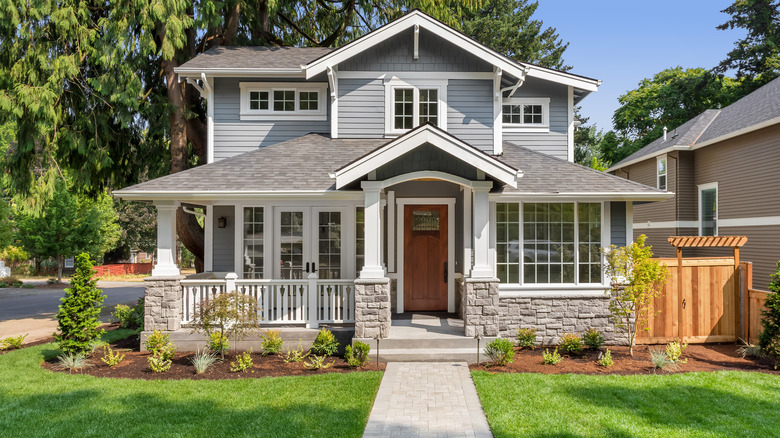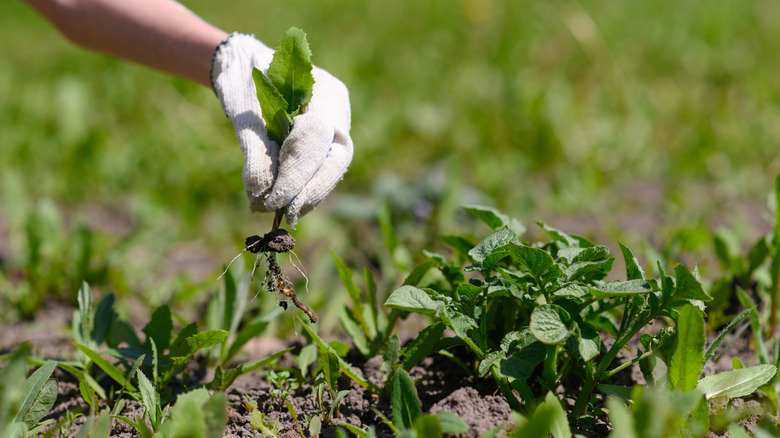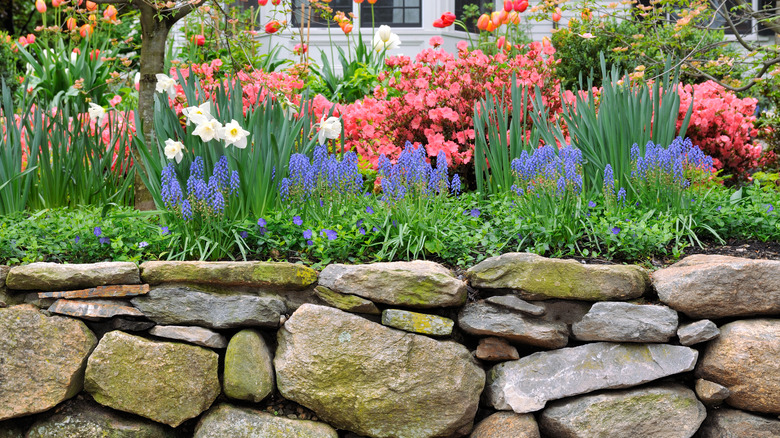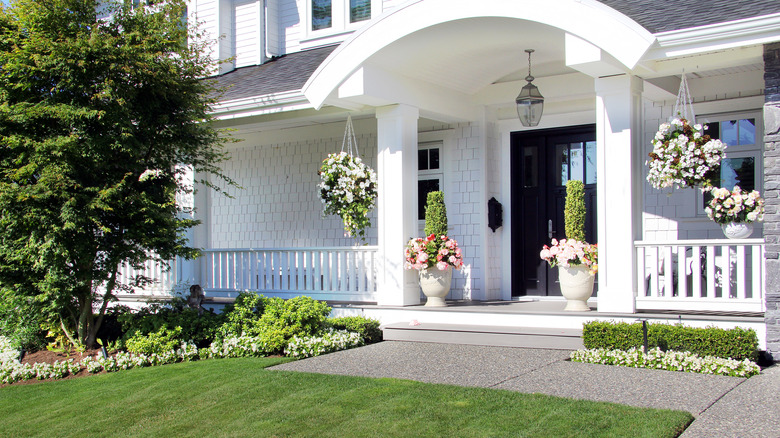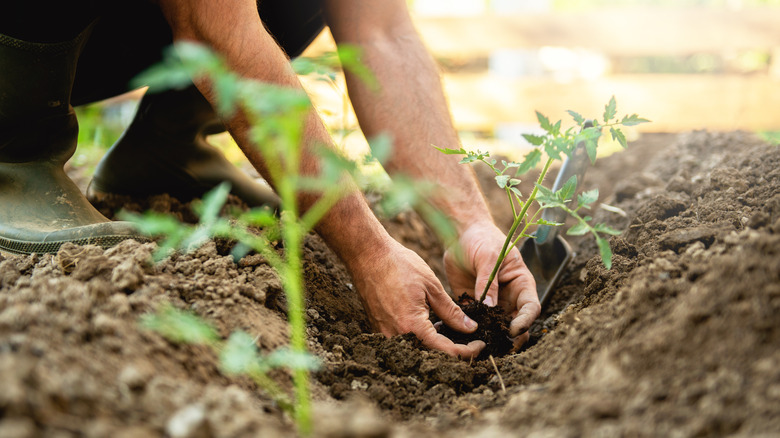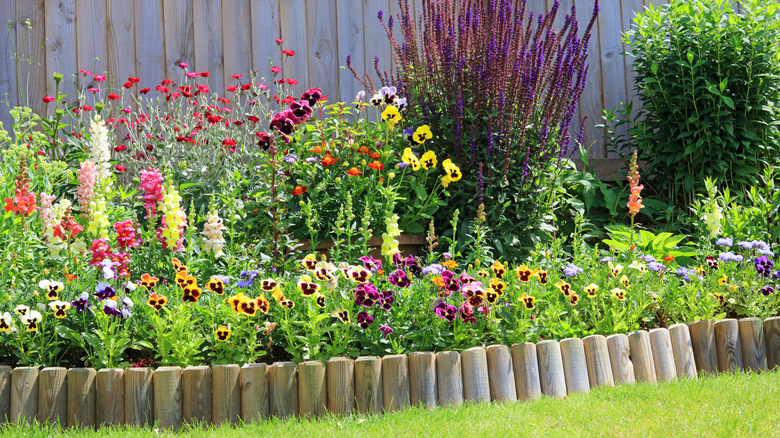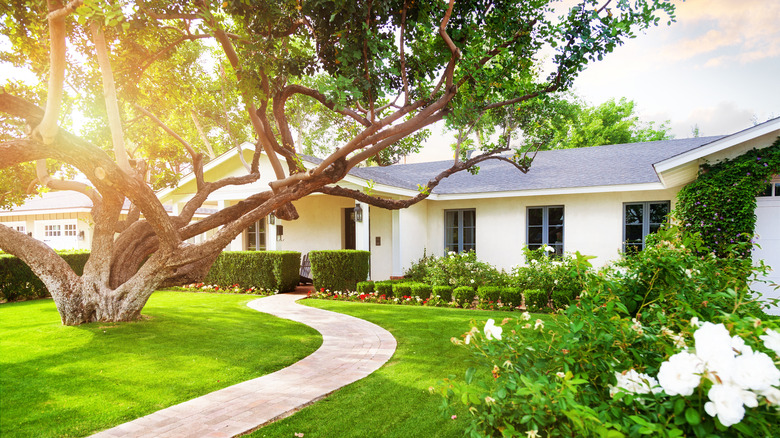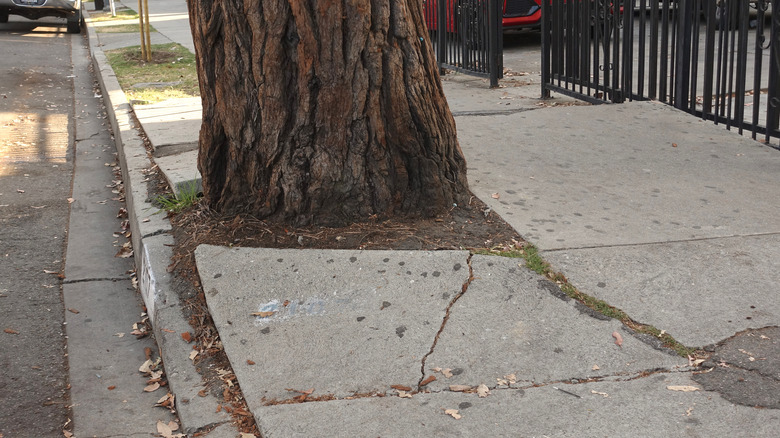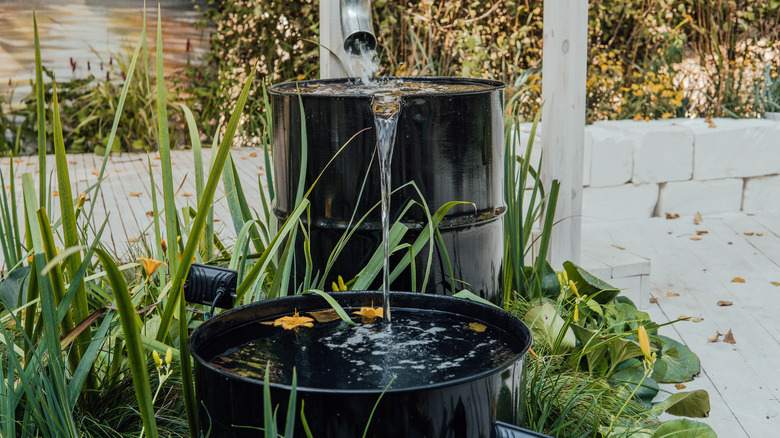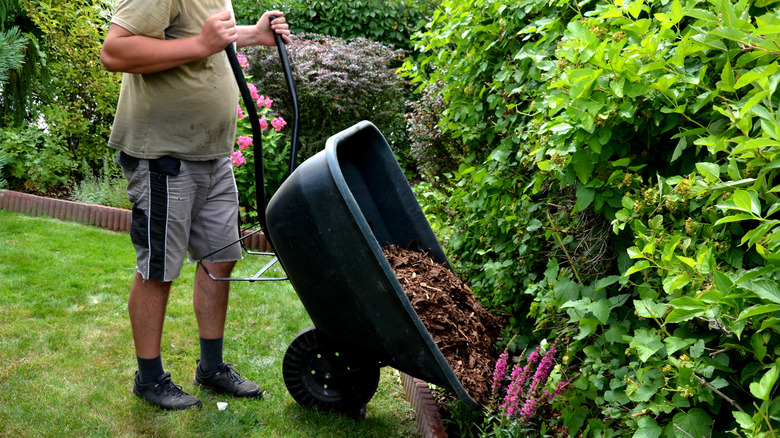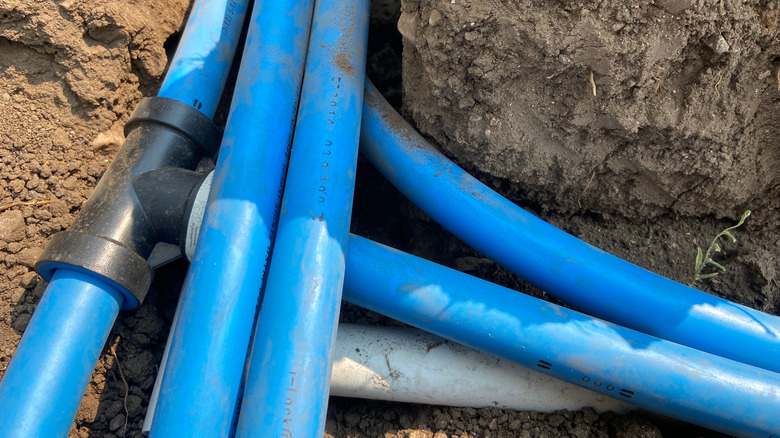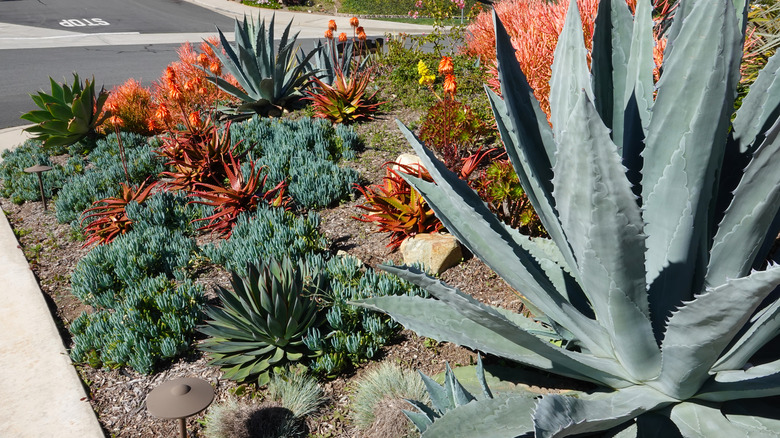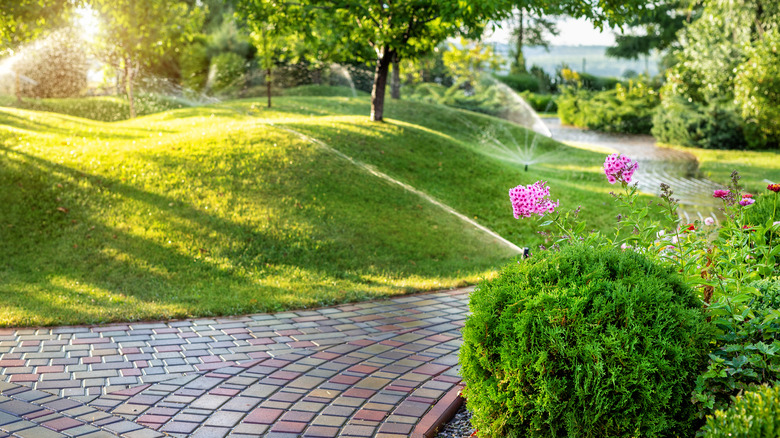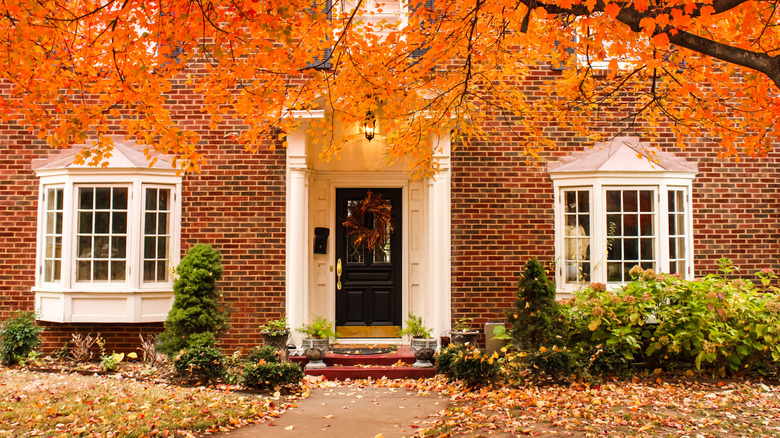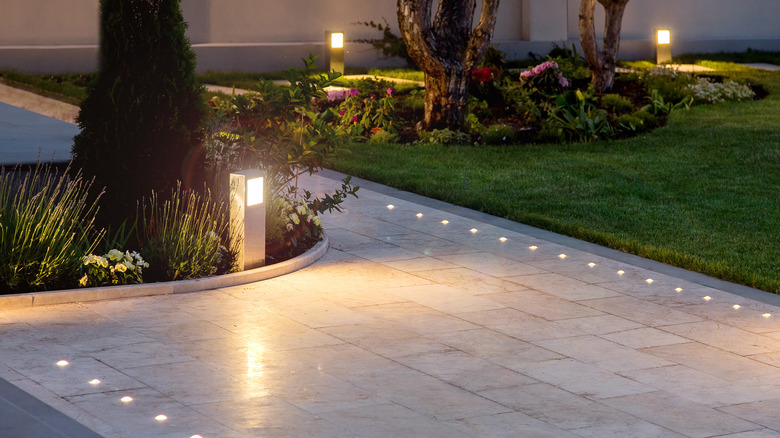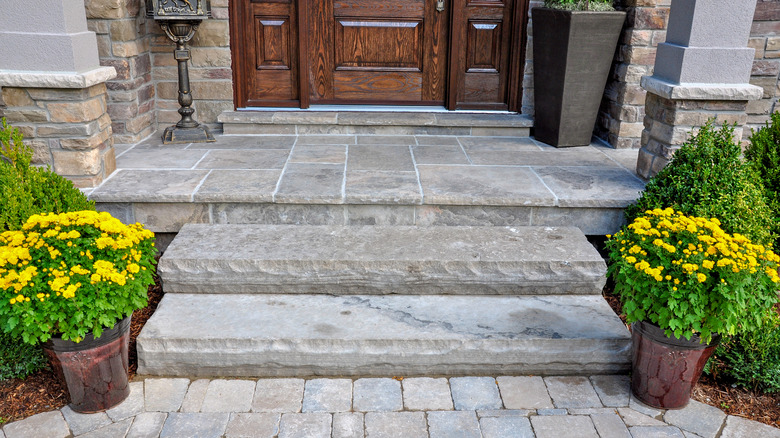15 Genius Tips For Landscaping Your Front Yard
When it comes time to shop around for a home, one of the top items on most prospective buyers' must-have lists is both a big backyard and an impressive front yard, per the Tennesseean. After all, when you're showing off your new digs to family and friends, the front yard is the very first place they'll see when they pull in — why not make a great first impression?
But if you have a larger backyard, you'll likely be spending most of your time out back, relaxing amidst the privacy and shade of the trees, rather than sitting out front for your new neighbors to see. It's entirely expected for homeowners to prioritize the maintenance and budget for any backyard to-dos, but let's face it: The front lawn needs some love, too! Luckily, it turns out that maintaining a five-star front yard isn't all that tough or expensive with the right landscaping tips and tricks under your belt.
1. Boil water to skip the weeding
Weeds ruin everything, but you can keep your front yard well maintained without manual labor. According to PH&G, all you have to do is dress in full-coverage clothes, put on gloves, bring a pot of water to a boil, then pour it over the area.
Whether it's stubborn weeds or pesky plants growing between your flowers, the water should do all of the work. You may need to do a few pours over time depending on how deeply rooted they are, but it still beats sweating away on a Saturday!
2. Know the different flower types
Instead of planting annuals like marigolds (tempting, we know), opt for perennials for your front yard if you want something lower maintenance. Annuals are cheaper and will be in a bright bloom all year, but they'll only survive one growing season and require a replant. Perennials, however, will last at least three growing seasons, since they have a dormant period before they bloom again. For the best of both worlds, try staggering the times that you plant a variety of perennials — that way, you'll have color in your front yard year-round, says HGTV.
3. Fill your planters
Potting your plants can allow for more elevation, more privacy, and are an opportunity to add some more texture and color to your front yard. But the best part? Making use of planters actually means you can purchase less material, which can cut down on the cost of your landscaping.
The Pottery Patch recommends skipping the extra unnecessary soil for potted plants, and instead, using lightweight filler to create some height. Since many plants typically don't require the entire planter's worth of soil, you can use things like recycled milk jugs, water bottles, or packing peanuts instead.
4. Ask your neighbors for scraps
New to the area, and not sure what to grow? Chances are your neighbors have already figured it out! Jim's Mowing explains that it's completely possible to grow a garden based on cuttings alone, so if you're stuck on what works best in your new area or climate, try asking the neighbors for a hand.
If they have any spare plant cuttings, you can plant those with confidence. Since your neighbors likely have the same soil and growing conditions in their own yards, you're bound to see success with their scraps.
5. Edge your garden
While it doesn't hurt to have a rogue flower bloom here and there, keeping everything streamlined will boost the curb appeal of your home. The best way to achieve an organized, polished front yard is with garden edging.
LawnStarter says that creating a border around your plants should control growth and stop weeds from popping up out of line. It can be as simple (and, subsequently, as cheap) as digging a small channel around the outside of the area. You can level up the look with a rock garden or hidden metal edging for a seamless look.
6. Plant some trees
Having a tree in your yard is the gift that keeps on giving. According to Mr. Tree Services, a tree on your lawn helps the environment and contributes shade to the front of your home.
Planting a tree in your yard also helps increase the property value of your home. Landscaping with trees can significantly affect its value — upwards of 20% — notes the Arbor Day Foundation. If you want to invest in your house and have it pay off, start by planting the best possible tree for the area.
7. Pick trees wisely
Before you go planting any seeds, however, be sure that the tree you're planting works for your front yard. Popular tree blog Davey says that all trees should be a minimum of 8 to 10 feet away from the home.
Some beloved trees are also known for wreaking absolute havoc on a neighborhood. Take, for instance, oak trees or weeping willows; while they may make your home stand out, you'll likely face foundation and cracked sidewalk issues when the roots get out of hand. Instead, create lower maintenance shade with crabapple, dogwood, or American holly trees.
8. Create a rain garden
Rain gardens are a designated, depressed portion of land that collect rain and filter water runoff before it hits the street's sewage drains (via the EPA). According to This Old House, building a run-off system is actually an easy project, so long as you're willing to hire general laborers or put in some manual DIY work yourself.
If you already intended on planting a garden to impress everyone on the block, consider putting it to work as a filtering system, too — just be sure to double-check for any underground pipes before you get digging.
9. Buy mulch in bulk
Gardening mulch is a great way to add some natural color to your landscaping, but always buy in bulk if possible! While bagged mulch may seem like a bargain because you don't need to pay a delivery fee, The Dirt Bag explains that it's actually the other way around — bulk mulch can cost considerably less.
Consider your space: Is there enough room to have a truck deliver the mulch? Do you have an area to store it until you spread it out? If so, then call around and get some estimates for your mulch order.
10. Disguise any pipes
The only thing worse than ruining your landscaping design with obvious pipes in the ground is striking them while working. But that doesn't make the former problem any less tough!
Start by painting the pipe to be a similar color to what you're surrounding it with. SF Gate suggests a coat of brown paint to disguise a pipe before covering it with mulch, just in case it pokes through. Another option is to hide the pipe from view with a decorative object, like a water feature, planter, or some natural rocks to help it blend in more easily.
11. Stick with succulents
Not every homeowner wants a rainbow spread of fresh, blooming flowers (and their accompanying bugs and bees, if we're being honest). If you want a more neutral landscape, but you don't want things to appear boring, try succulents.
Jim's Mowing says succulents are a great swap for flowers, since they can easily be interchanged with grass in a design, and they're simple to care for. They'll work well in any climate, too. With succulents, you don't have to worry about the heat ruining your perennial progress — or your home's curb appeal as a result.
12. Install an irrigation system
The last thing you want to do is craft the perfect yard just to have it turn dry and dreary as the months wear on. That's why you should try to squeeze an irrigation system into your budget.
You should set aside about $3,000 for the project, says New Home Source. But the payoff will come quickly — you won't run the risk of over or under watering your lawn, the water bill will be regulated, future buyers might pay more for your property, and you'll never have to worry about turning off the sprinklers again.
13. Mow the leaves
You've probably never heard of "leaf mulching," and that's what makes this little-known landscaping tip from lawn care brand Scotts so genius. Instead of raking up all of the leaves, try mowing directly over them.
All you have to do is remove the grass catcher from your mower and go to town. You don't even have to pick up the remnants after! Instead, let the leaves slowly break down in the grass, and let nature do its thing. This will essentially "feed" your lawn and give you much richer soil to work with next spring.
14. Highlight your home with lighting
With all of the hard work that's gone into those perennials, your front yard deserves to be seen during the day or night. Home Depot recommends using a variety of lights in your front yard, depending on what you're looking for.
Try to match the tone of your lighting with what you wish to highlight. Plants should be accompanied by cooler lights, while artificial features like bird baths look best against warm lights. Cool lights will help the front yard seem bigger, and warm lights make your yard extra inviting and cozy.
15. Consider adding hardscaping
Hardscaping is the part of landscaping that's human made — think concrete, brick, and metal. A lush lawn makes a noticeable impact, but there's something special about contrasting greenery with rugged material.
Try incorporating low-maintenance hardscaping with your walkway. Instead of a dirt path, spring for a brick focal piece. The Spruce says to compliment with "softscaping," or the art of designing everything natural into a landscape. The two approaches will balance each other out, and the end result will be a unique front yard sure to leave a lasting impression on any guest or neighbor!
